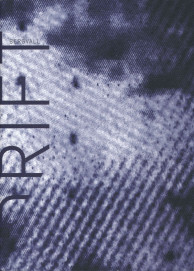 Caroline Bergvall
Caroline Bergvall
Nightboat Books ($19.95)
by Greg Bem
What is the nature of inquiry? What does it mean to “ask the question”? How does the poetic process have an impact on cultural excavation? Caroline Bergvall’s compelling Drift explores these questions and more. A larger project made up of linked components, this book is overwhelmed with the thoughts of an immense ethnographic space, a vast cultural chamber—one that exists above and around the poet, but also through which Bergvall approaches herself. She is the ongoing researcher, the protagonist bent upon seeking a truth through attentiveness:
The room was busy
the living were noisy
crowding out the place
the dead were marching through
noone was paying attention
thats when I started to
Opening this book is therefore akin to starting a quest, a quest for structure and truth amidst bending language and capsizing vessels of thought. We begin with a sequence of sixteen illustrations that may be tornados, monsoons, erased texts, sound waves, seismographic recordings, or even a contemplative scribble. Ultimately the mind wanders toward an interpretation of wind: scratches as broad in breadth as a blast of air. These pages open us to a windy sea.
“Seafarer” is the first text proper the reader encounters, and it’s posited behind a weave of narratives, navigations, and histories. Starting Drift, we become adrift in Bergvall’s own waves of material, to be awoken upon raging seas, cruel coastlines, and a bountiful “beyond” drawing us closer:
. . . gewacked by
seachops gave up all parts of me on gebattered
ship Yet a hungor innan mind stole me to more
weird comas let me let me let me let me freeze
Blow wind blow, anon am I
As the book’s source notes confirm, such text “uses and spins off from” medieval Anglo-Saxon quest poetry, making Drift at least partially a crisp but dauntingly abstracted series of translations. Mercy is not spared for the reader, who must read cryptically along the wash and noise of a dense set of song cycles. We are given the gift of anonymity by being readers: in the case of Drift, there is the anonymity of truth, of authorship, and of Bergvall’s conceptual conditionings and constraints.
In the moments we see translation, we witness erasure. We feel the currents of energy Bergvall passes from what she has read to that which she writes. A well-lit process hides behind the text itself, steaming out from beneath the printed characters in patterns. Patterns and cycles imbue the text with an aloofness, a quality of shuddering, a touch of transition: the flotsam and jetsam of language. Take the poet’s powerful and mysterious mash-up below, for instance:
Beat bells blow foghorns! Gebangbang for rumbly lowe!
When will the wind come? Where will the wind from come?
Will it come from the naught, bringing phobias and rationing?
Drift brings us statements and questions and deciphering and none of it is neat, as it need not be. Its joy is one of endurance, of fatigue, and of engaging an environment of poetry larger than ego, fathomable and intense. That which is represented is then tweaked, morphed, sculpted. But why?
The reader must hold off answering until the book’s finale. Truth is a moment of climax and authority, but the journey must be undertaken for the lessons to be learned. No clearer has the poet provided truth in journey than through “Report,” arguably the most powerful and the most anonymous space of the book. In it we follow, through ghostly reports and pixelated images, the deadly journey of Libyan migrants toward Italy. Their failed quest poses the ultimate question: why were they allowed to die? But more importantly, Bergvall’s own audacity to print this spectrum of her path of inquiry provokes, pokes, and prods the reader to dread in ways medieval poetry cannot. “This compass and the stars were their only means of orientation at this point,” she writes. And yet the language maintains a distance, a coldness, an anonymity. The poet is alive amidst the forceful, displacing currents of the tide.
Bergvall’s cunning poetry is born out of ideas. At the end of Drift, she provides the reader with a day journal, called “Log,” filled with hopes and imaginations. “To remind myself that this project is not an exercise in translation, however closely I work with the original text. It is a template for writing. And for excavating language. For finding the teeth of my own text, for locating its workable memory trails” Her insight is precious; it sorts out value for us, and becomes the warm heart of anthropology within an array of messy movements, of poetic image and sonic buzz scattered throughout the 185 pages of Drift. Reading them, we enter what feels maddening, and incorrigibly raw: the captain’s chambers in a gargantuan craft floating across an abyss of vision.

